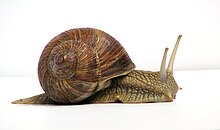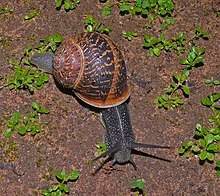
Back حلزون أرضي Arabic Caragol de terra Catalan Landschnecken German حلزون خاکی Persian Ốc cạn Vietnamese



A land snail is any of the numerous species of snail that live on land, as opposed to the sea snails and freshwater snails. Land snail is the common name for terrestrial gastropod mollusks that have shells (those without shells are known as slugs). However, it is not always easy to say which species are terrestrial, because some are more or less amphibious between land and fresh water, and others are relatively amphibious between land and salt water.
Land snails are a polyphyletic group comprising at least ten independent evolutionary transitions to terrestrial life (the last common ancestor of all gastropods was marine).[1][2][3][4][5] The majority of land snails are pulmonates that have a lung and breathe air. Most of the non-pulmonate land snails belong to lineages in the Caenogastropoda, and tend to have a gill and an operculum. The largest clade of land snails is the Cyclophoroidea, with more than 7,000 species.[6] Many of these operculate land snails live in habitats or microhabitats that are sometimes (or often) damp or wet, such as in moss.
Land snails have a strong muscular foot; they use mucus to enable them to crawl over rough surfaces and to keep their soft bodies from drying out. Like other mollusks, land snails have a mantle, and they have one or two pairs of tentacles on their head. Their internal anatomy includes a radula and a primitive brain. In terms of reproduction, many caenogastropod land snails (e.g., diplommatinids) are dioecious,[7][8] but pulmonate land snails are hermaphrodites (they have a full set of organs of both sexes) and most lay clutches of eggs in the soil. Tiny snails hatch out of the egg with a small shell in place, and the shell grows spirally as the soft parts gradually increase in size. Most land snails have shells that are right-handed in their coiling.
A wide range of different vertebrate and invertebrate animals prey on land snails. They are used as food by humans in various cultures worldwide, and are raised on farms in some areas for use as food.
- ^ Vermeij, Geerat J.; Dudley, Robert (2000-08-01). "Why are there so few evolutionary transitions between aquatic and terrestrial ecosystems?". Biological Journal of the Linnean Society. 70 (4): 541–554. doi:10.1111/j.1095-8312.2000.tb00216.x. ISSN 0024-4066.
- ^ Rosenberg, Gary (1996). "Independent Evolution of Terrestriality in Atlantic Truncatellid Gastropods". Evolution. 50 (2): 682–693. doi:10.1111/j.1558-5646.1996.tb03878.x. ISSN 1558-5646. PMID 28568923.
- ^ Kameda, Yuichi; Kato, Makoto (2011-05-05). "Terrestrial invasion of pomatiopsid gastropods in the heavy-snow region of the Japanese Archipelago". BMC Evolutionary Biology. 11 (1): 118. Bibcode:2011BMCEE..11..118K. doi:10.1186/1471-2148-11-118. ISSN 1471-2148. PMC 3102040. PMID 21545707.
- ^ Romero, Pedro E.; Pfenninger, Markus; Kano, Yasunori; Klussmann-Kolb, Annette (2016-04-01). "Molecular phylogeny of the Ellobiidae (Gastropoda: Panpulmonata) supports independent terrestrial invasions". Molecular Phylogenetics and Evolution. 97: 43–54. Bibcode:2016MolPE..97...43R. doi:10.1016/j.ympev.2015.12.014. ISSN 1055-7903. PMID 26724408.
- ^ Bullis, David A.; Herhold, Hollister W.; Czekanski-Moir, Jesse E.; Grimaldi, David A.; Rundell, Rebecca J. (2020-03-01). "Diverse new tropical land snail species from mid-Cretaceous Burmese amber (Mollusca: Gastropoda: Cyclophoroidea, Assimineidae)". Cretaceous Research. 107: 104267. Bibcode:2020CrRes.10704267B. doi:10.1016/j.cretres.2019.104267. ISSN 0195-6671. S2CID 210289753.
- ^ "Molluscabase". molluscabase.org. Retrieved 2020-07-30.
- ^ Reichenbach, Fabian; Baur, Hannes; Neubert, Eike (2012-07-17). "Sexual dimorphism in shells of Cochlostoma septemspirale (Caenogastropoda, Cyclophoroidea, Diplommatinidae, Cochlostomatinae)". ZooKeys (208): 1–16. Bibcode:2012ZooK..208....1R. doi:10.3897/zookeys.208.2869. ISSN 1313-2989. PMC 3406443. PMID 22859868.
- ^ Collin, Rachel (2018), Leonard, Janet L. (ed.), "Transitions in Sexual and Reproductive Strategies Among the Caenogastropoda", Transitions Between Sexual Systems: Understanding the Mechanisms of, and Pathways Between, Dioecy, Hermaphroditism and Other Sexual Systems, Cham: Springer International Publishing, pp. 193–220, doi:10.1007/978-3-319-94139-4_7, ISBN 978-3-319-94139-4